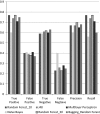CARDIO-PRED: an in silico tool for predicting cardiovascular-disorder associated proteins
- PMID: 25972989
- PMCID: PMC4427582
- DOI: 10.1007/s11693-015-9164-z
CARDIO-PRED: an in silico tool for predicting cardiovascular-disorder associated proteins
Abstract
Interactions between proteins largely govern cellular processes and this has led to numerous efforts culminating in enormous information related to the proteins, their interactions and the function which is determined by their interactions. The main concern of the present study is to present interface analysis of cardiovascular-disorder (CVD) related proteins to shed lights on details of interactions and to emphasize the importance of using structures in network studies. This study combines the network-centred approach with three dimensional studies to comprehend the fundamentals of biology. Interface properties were used as descriptors to classify the CVD associated proteins and non-CVD associated proteins. Machine learning algorithm was used to generate a classifier based on the training set which was then used to predict potential CVD related proteins from a set of polymorphic proteins which are not known to be involved in any disease. Among several classifying algorithms applied to generate models, best performance was achieved using Random Forest with an accuracy of 69.5 %. The tool named CARDIO-PRED, based on the prediction model is present at http://www.genomeinformatics.dce.edu/CARDIO-PRED/. The predicted CVD related proteins may not be the causing factor of particular disease but can be involved in pathways and reactions yet unknown to us thus permitting a more rational analysis of disease mechanism. Study of their interactions with other proteins can significantly improve our understanding of the molecular mechanism of diseases.
Keywords: 3-Dimensional structure; Cardiovascular-disorder; Interface properties; Machine learning; Network analysis.
Figures





Similar articles
-
AFP-Pred: A random forest approach for predicting antifreeze proteins from sequence-derived properties.J Theor Biol. 2011 Feb 7;270(1):56-62. doi: 10.1016/j.jtbi.2010.10.037. Epub 2010 Nov 4. J Theor Biol. 2011. PMID: 21056045
-
3dswap-pred: prediction of 3D domain swapping from protein sequence using Random Forest approach.Protein Pept Lett. 2011 Oct;18(10):1010-20. doi: 10.2174/092986611796378729. Protein Pept Lett. 2011. PMID: 21592079
-
MPLs-Pred: Predicting Membrane Protein-Ligand Binding Sites Using Hybrid Sequence-Based Features and Ligand-Specific Models.Int J Mol Sci. 2019 Jun 26;20(13):3120. doi: 10.3390/ijms20133120. Int J Mol Sci. 2019. PMID: 31247932 Free PMC article.
-
RPI-Pred: predicting ncRNA-protein interaction using sequence and structural information.Nucleic Acids Res. 2015 Feb 18;43(3):1370-9. doi: 10.1093/nar/gkv020. Epub 2015 Jan 21. Nucleic Acids Res. 2015. PMID: 25609700 Free PMC article.
-
Hemolytic-Pred: A machine learning-based predictor for hemolytic proteins using position and composition-based features.Digit Health. 2023 Jul 5;9:20552076231180739. doi: 10.1177/20552076231180739. eCollection 2023 Jan-Dec. Digit Health. 2023. PMID: 37434723 Free PMC article.
References
-
- Aung Z (2006) Computational analysis of 3D protein structures. Doctoral dissertation, School of Computing, National Institute of Singapore
-
- Calvo S, Jain M, Xie X, Sheth SA, Chang B, Goldberger OA, Spinazzola A, Zeviani M, Carr SA, Mootha VK (2006) Systematic identification of human mitochondrial disease genes through integrative genomics. Nat Genet 38(5):576–582. doi:10.1038/ng1776 - PubMed
LinkOut - more resources
Full Text Sources
Other Literature Sources

